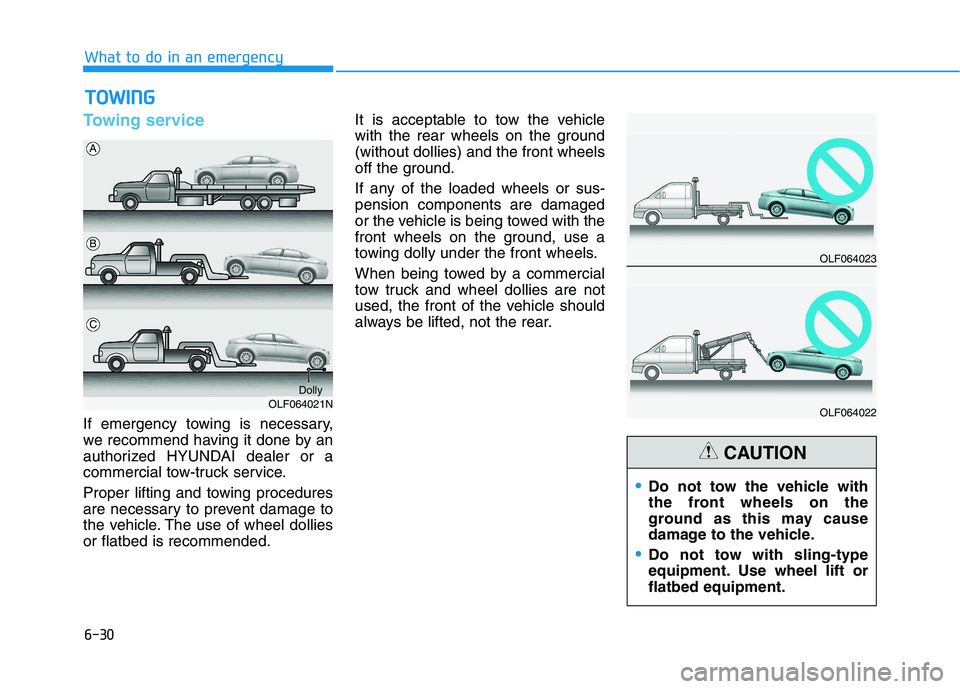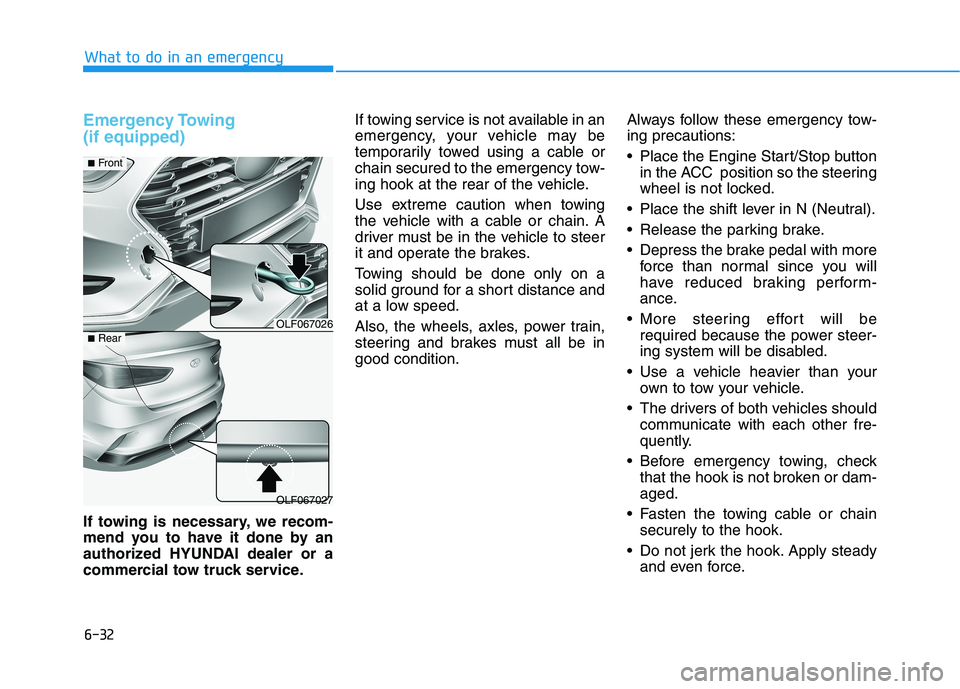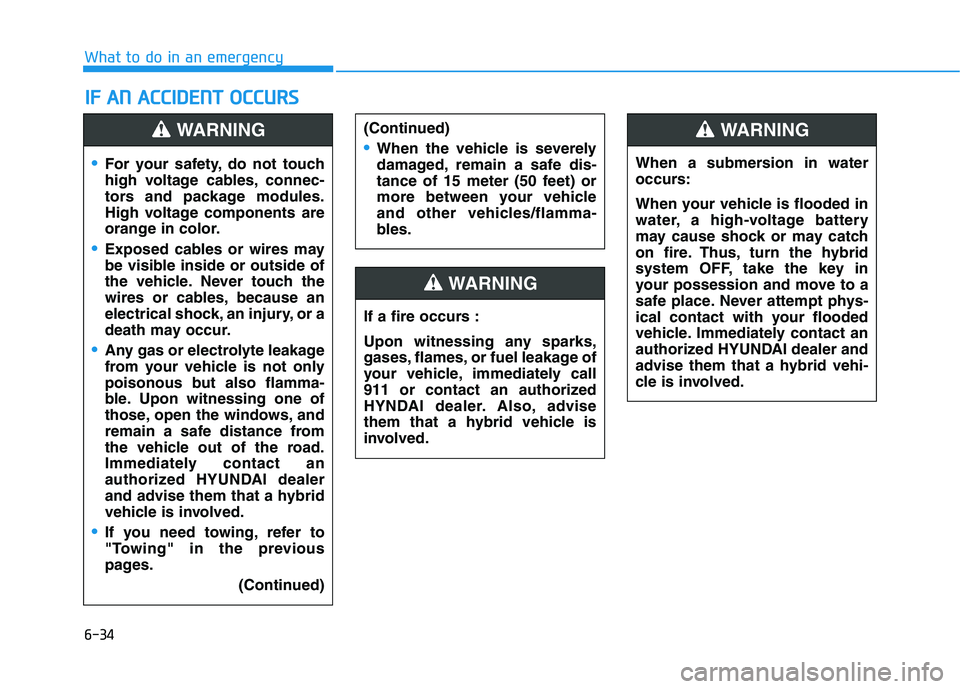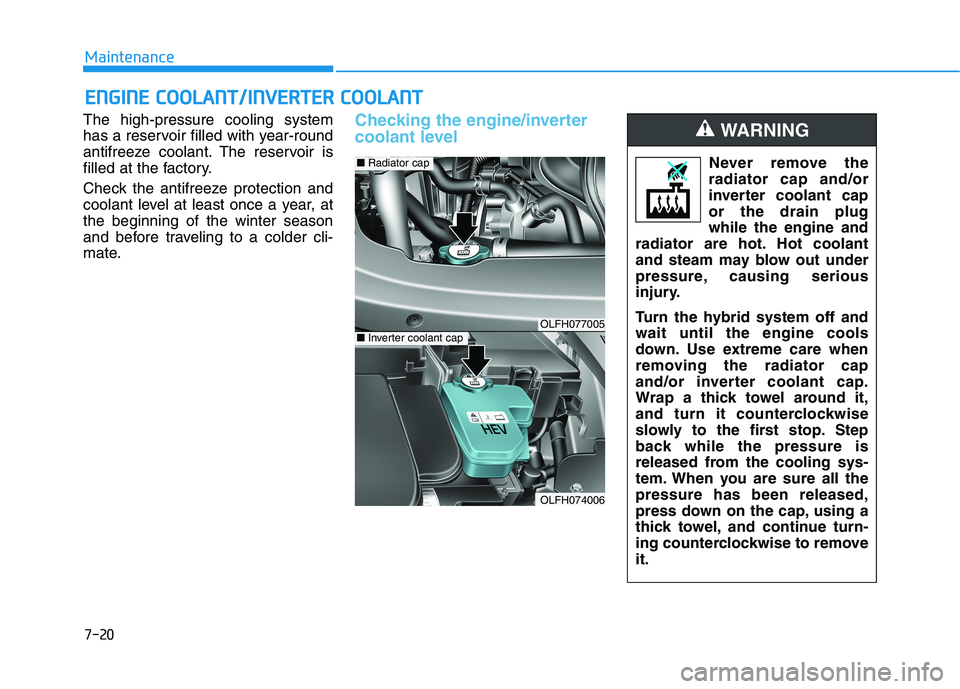Page 432 of 546

6-30
Towing service
If emergency towing is necessary,
we recommend having it done by an
authorized HYUNDAI dealer or a
commercial tow-truck service.
Proper lifting and towing procedures
are necessary to prevent damage to
the vehicle. The use of wheel dolliesor flatbed is recommended.It is acceptable to tow the vehicle
with the rear wheels on the ground(without dollies) and the front wheels
off the ground.
If any of the loaded wheels or sus- pension components are damaged
or the vehicle is being towed with the
front wheels on the ground, use a
towing dolly under the front wheels.
When being towed by a commercial
tow truck and wheel dollies are not
used, the front of the vehicle should
always be lifted, not the rear.
TT
OO WW IINN GG
What to do in an emergency
OLF064021N
A
B
C
Dolly
OLF064023
OLF064022
Do not tow the vehicle with
the front wheels on the
ground as this may cause
damage to the vehicle.
Do not tow with sling-type
equipment. Use wheel lift orflatbed equipment.
CAUTION
Page 433 of 546
6-31
What to do in an emergency
6
When towing your vehicle in an emergency without wheel dollies :
1. Place the Engine Start/Stop but-ton in the ACC position.
2. Place the shift lever in N (Neutral).
3. Release the parking brake.Removable towing hook
1. Open the trunk, and take the tow- ing hooks out from the tool case. 2. Open the cover by pressing the
lower part on the front bumper.
3. Install the towing hook by rotating it in a clock-wise direction until it is securely installed.
4. After use, remove the towing hook and close the cover.
Failure to place the transmis-
sion shift lever in N (Neutral)
may cause internal damage tothe transmission.
CAUTION
OLFH064024
OLFP065024
■
Hybrid
■Plug-in hybrid
OLF067025
Page 434 of 546

6-32
What to do in an emergency
Emergency Towing (if equipped)
If towing is necessary, we recom-
mend you to have it done by an
authorized HYUNDAI dealer or a
commercial tow truck service.If towing service is not available in an
emergency, your vehicle may be
temporarily towed using a cable or
chain secured to the emergency tow-
ing hook at the rear of the vehicle.
Use extreme caution when towing
the vehicle with a cable or chain. A
driver must be in the vehicle to steer
it and operate the brakes.
Towing should be done only on a
solid ground for a short distance and
at a low speed.
Also, the wheels, axles, power train,
steering and brakes must all be ingood condition.
Always follow these emergency tow-ing precautions:
Place the Engine Start/Stop button
in the ACC position so the steering
wheel is not locked.
Place the shift lever in N (Neutral).
Release the parking brake.
Depress the brake pedal with more force than normal since you will
have reduced braking perform-
ance.
More steering effort will be required because the power steer-
ing system will be disabled.
Use a vehicle heavier than your own to tow your vehicle.
The drivers of both vehicles should communicate with each other fre-
quently.
Before emergency towing, check that the hook is not broken or dam-aged.
Fasten the towing cable or chain securely to the hook.
Do not jerk the hook. Apply steady and even force.
OLF067026
OLF067027
■Front
■Rear
Page 435 of 546
6-33
What to do in an emergency
Use a towing cable or chain lessthan 5 m (16 feet) long. Attach a white or red cloth (about 30 cm (12inches) wide) in the middle of the
cable or chain for easy visibility.
Drive carefully so the towing cable or chain remains tight during tow-ing.
Before towing, check the automat- ic transmission for fluid leaks under
your vehicle. If the automatic trans-mission fluid is leaking, flatbed
equipment or a towing dolly mustbe used.
6
ODH063025 To avoid damage to your vehicle
and vehicle components when
towing:
Always pull straight ahead
when using the towing hooks.
Do not pull from the side or at
a vertical angle.
Do not use the towing hooks
to pull a vehicle out of mud,
sand or other conditions from
which the vehicle cannot be
driven out under its own
power.
Limit the vehicle speed to 15 km/h (10 mph) and drive less
than 1.5 km (1 mile) when tow-
ing to avoid serious damageto the automatic transmis-sion.
CAUTION
Page 436 of 546

6-34
IIFF AA NN AA CCCCIIDD EENN TT OO CCCCUU RRSS
What to do in an emergency
For your safety, do not touch
high voltage cables, connec-
tors and package modules.
High voltage components are
orange in color.
Exposed cables or wires may
be visible inside or outside of
the vehicle. Never touch the
wires or cables, because an
electrical shock, an injury, or a
death may occur.
Any gas or electrolyte leakage
from your vehicle is not only
poisonous but also flamma-
ble. Upon witnessing one of
those, open the windows, and
remain a safe distance from
the vehicle out of the road.
Immediately contact an
authorized HYUNDAI dealer
and advise them that a hybrid
vehicle is involved.
If you need towing, refer to
"Towing" in the previous
pages. (Continued)
(Continued)
When the vehicle is severely
damaged, remain a safe dis-
tance of 15 meter (50 feet) or
more between your vehicle
and other vehicles/flamma-
bles.
WARNING
If a fire occurs :
Upon witnessing any sparks,
gases, flames, or fuel leakage of
your vehicle, immediately call
911 or contact an authorized
HYNDAI dealer. Also, advise
them that a hybrid vehicle is
involved.
WARNING
When a submersion in water
occurs:
When your vehicle is flooded in
water, a high-voltage battery
may cause shock or may catch
on fire. Thus, turn the hybrid
system OFF, take the key in
your possession and move to a
safe place. Never attempt phys-
ical contact with your flooded
vehicle. Immediately contact an
authorized HYUNDAI dealer and
advise them that a hybrid vehi-
cle is involved.
WARNING
Page 452 of 546
Maintenance
Severe driving conditions
A - Repeatedly driving short distance of less than 8 km (5miles) in normal temperature or less than 16 km (10 miles)
in freezing temperature
B - Extensive engine idling or low speed driving for long dis- tances
C - Driving on rough, dusty, muddy, unpaved, graveled or salt- spread roads
D - Driving in areas using salt or other corrosive materials or in very cold weather
E - Driving in sandy areas F - Driving in heavy traffic area over 32°C (90°F)
G - Driving on uphill, downhill, or mountain road
H - Towing a Trailer, or using a camper, or roof rack
I - Driving as a patrol car, taxi, other commercial use or vehi-
cle towing
J - Driving over 170 km/h (106 mph)
K - Frequently driving in stop-and-go conditions
L - Frequently driving in rainy areas
MAINTENANCE ITEMMAINTENANCE OPERATIONMAINTENANCE INTERVALSDRIVING
CONDITION
CLIMATE CONTROL AIR FILTER
(FOR EVAPORATOR AND BLOWER UNIT)RMORE FREQUENTLYC, E
7-14
Page 458 of 546

7-20
MaintenanceE
E NN GGIINN EE CC OO OO LLAA NN TT//IINN VVEERR TTEERR CC OO OO LLAA NN TT
The high-pressure cooling system
has a reservoir filled with year-round
antifreeze coolant. The reservoir is
filled at the factory.
Check the antifreeze protection and
coolant level at least once a year, atthe beginning of the winter season
and before traveling to a colder cli-
mate.Checking the engine/inverter
coolant level
OLFH077005
OLFH074006
■Radiator cap
■Inverter coolant cap
Never remove the
radiator cap and/or
inverter coolant capor the drain plugwhile the engine and
radiator are hot. Hot coolant
and steam may blow out under
pressure, causing serious
injury.
Turn the hybrid system off and wait until the engine cools
down. Use extreme care when
removing the radiator cap
and/or inverter coolant cap.
Wrap a thick towel around it,
and turn it counterclockwise
slowly to the first stop. Step
back while the pressure is
released from the cooling sys-
tem. When you are sure all thepressure has been released,
press down on the cap, using a
thick towel, and continue turn-
ing counterclockwise to removeit.
WARNING
Page 461 of 546

7-23
7
Maintenance
Changing engine coolant
Have coolant changed by an author-
ized HYUNDAI dealer according tothe Maintenance Schedule at the
beginning of this chapter.
To prevent damage to engine
parts, put a thick towel around the
radiator cap before refilling the
coolant to prevent the coolant
from overflowing into engine
parts, such as the generator.
Checking the hybrid starter &
generator (HSG) belt
Have the hybrid starter & generator (HSG) belt inspected or replacedaccording to the Maintenance
Schedule in this chapter by an
authorized HYUNDAI dealer.
NOTICE
HHYY BBRRIIDD SS TT AA RRTTEERR && GG EENN EERR AA TTOO RR (( HH SSGG )) BB EELLTT
Turn the vehicle off while you
inspect the engine or hybrid
starter & generator (HSG)
belt. Otherwise it may result in
serious injury.
Keep hands, clothing etc.
away from the hybrid starter &
generator (HSG) belt.
WARNING
When the HSG belt is worn out
or damaged, replace the belt.
Otherwise, it may cause engine
overheating or battery dis-
charge.
CAUTIONDo not use engine coolant or
antifreeze in the washer fluid
reservoir.
Engine coolant can severely
obscure visibility when sprayed
on the windshield and may
cause loss of vehicle controlresulting in an accident.
Engine coolant may also cause
damage to paint and body trim.
WARNING